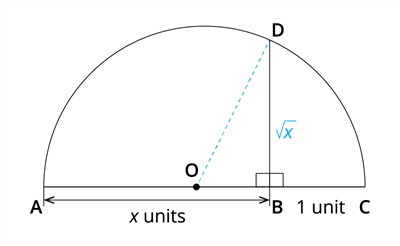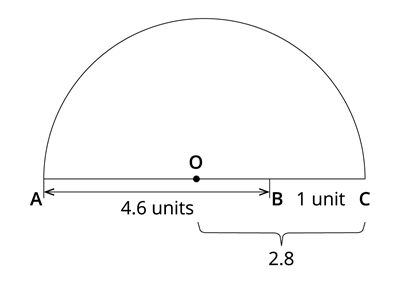PDF chapter test TRY NOW
Let us recall the concept of the square number we learned so far.
If 'a' is a natural number, then = b. That is, b² = a and b > 0.
We are now going to extend the same definition to positive real numbers.
If a > 0 be a real number, then = b. That is, b² = a and b > 0.
Let us learn how to find for any given positive real number 'x' geometrically.
The general procedure to represent geometrically:
Step 1: If the given positive number is 'x' we have to mark 'B' so that AB = x units.

Step 2: From point 'B', mark a distance of 1 unit and label the point as 'C'. That is BC =1 unit.

Step 3: Now find the midpoint of AC and mark the midpoint as 'O'.

Step 4: Draw a semicircle with centre 'O' and radius OC.

Step 5: Draw a line perpendicular to AC which passes through point 'B' and intersect the semicircle at 'D' such that ∠OBD = 90°.

Step 6: Now measure the length of BD, which is nothing but .

Let us verify the value by applying Pythagoras theorem.
Consider the right triangle OBD.
OD²=OB²+BD²
We know that OD = OC(radius).
Here AC = AB +BC = x+1. So OC = (x+1)/2 = OD .
Then OB = OC - 1 = (x+1)/2 -1 = (x-1)/2.
Thus, the length of BD gives the value of .
Example:
Now we will try to find square root for the number 4.6
Step 1: If the given positive number is 'x' we have to mark 'B' so that AB = 4.6 units.

Step 2: From point 'B', mark a distance of 1 unit and label the point as 'C'. That is BC =1 unit.

Step 3: Now find the midpoint of AC = 4.6+1 = 5.6 units and mark the midpoint as 'O'.

Step 4: Draw a semicircle with centre 'O' and radius OC =5.6/2 = 2.8 units.

Step 5: Draw a line perpendicular to AC which passes through point 'B' and intersect the semicircle at 'D' such that ∠OBD = 90°.

Step 6: Now measure the length of BD = 2.145 which is nothing but .

Let us verify the value by applying Pythagoras theorem.
Consider the right triangle OBD.
OD²=OB²+BD²
We know that OD = OC = 2.8 (radius).
Now OB = OC - BC = 2.8-1 = 1.8 units.
